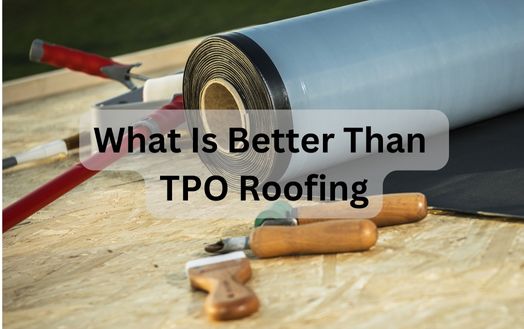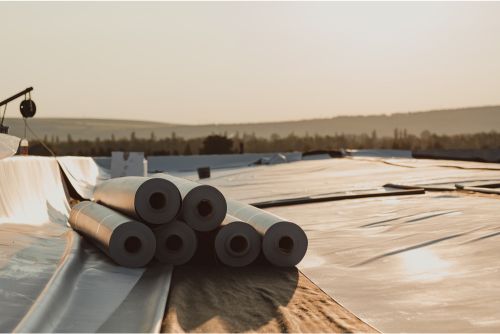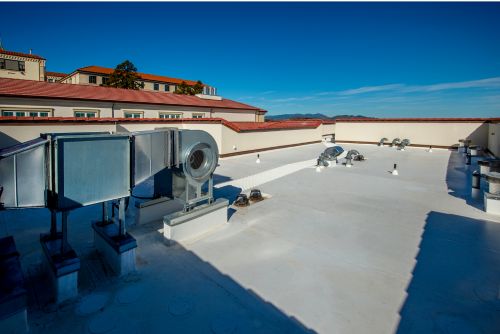
When it comes to commercial roofing, finding the right material is crucial for the longevity, durability, and energy efficiency of the building. TPO roofing, or thermoplastic polyolefin roofing, has gained popularity in recent years due to its affordability and energy-saving features. However, there are alternative roofing options that may offer even better benefits. In this blog, we will explore the composition, pros, and cons of TPO roofing, as well as two popular alternatives—PVC roofing and EPDM roofing. By comparing the qualities, costs, and performance of these roofing materials, building owners can make an informed decision on which option best suits their needs.
TPO roofing is a thermoplastic roofing system that consists of a single-ply membrane. This roofing material is known for its durability, energy efficiency, and cost-effectiveness. The seams of TPO roofing are heat-welded, creating a watertight seal that minimizes the risk of commercial leak repair NJ. TPO membranes range in thickness from 45 to 80 mils, providing longevity and durability. The composition of TPO roofing includes polymers, making it resistant to harsh chemicals and environmental impact. Additionally, TPO roofing membranes have insulation properties that reflect UV rays, reducing energy costs.
TPO roofs are made of thermoplastic polyolefin, a durable membrane. The composition of TPO roofing includes a blend of polypropylene and ethylene propylene rubber. This combination creates a roofing material that is resistant to UV rays, ozone, and chemicals, making it a popular choice for commercial buildings. TPO roofing systems consist of a scrim that provides strength, flexibility, and dimensional stability. The top layer of TPO membranes is designed to reflect sunlight, reducing energy costs and improving overall energy efficiency. With its composition and design, TPO roofing systems offer excellent weather resistance, durability, and longevity.
TPO roofing systems offer several benefits that make them an attractive choice for commercial roofing. One of the key advantages of TPO roofing is its energy efficiency. The reflective properties of TPO membranes help reduce energy costs by minimizing heat absorption and keeping the building cool. This energy efficiency can result in significant savings over time. Additionally, TPO roofs are known for their durability, lifespan, and resistance to leaks. With proper installation and maintenance, TPO roofing systems can exceed 30 years, making them a long-lasting option for building owners. Furthermore, TPO membranes provide excellent foot traffic resistance, which is ideal for commercial buildings with high foot traffic.
While TPO roofing has many advantages, it also has some drawbacks that building owners should consider. One potential challenge with TPO roofing is the adhesives used in the roof system, particularly in warmer climates. Adhesive failure can lead to membrane separation and, ultimately, leaks. Additionally, foot traffic on TPO roofs can impact the longevity and performance of the roof system, potentially causing punctures and other issues. Over time, TPO membranes can also shrink, which may affect the seams and increase the risk of leaks. Another consideration is that TPO roofing systems may require more maintenance compared to other roofing materials due to the material’s cons. Lastly, TPO roofing systems may be adversely affected by exposure to harsh environmental elements, potentially reducing their durability.

While TPO roofing is a popular option, there are alternative roofing materials available that offer unique advantages. Two options worth considering are PVC roofing and EPDM roofing. Both PVC and EPDM roofs have their own set of benefits, ranging from durability to energy efficiency. By understanding the differences between these roofing materials, building owners can make an informed decision when it comes to selecting the best option for their roofing needs. Let’s take a closer look at the characteristics and advantages of PVC roofing and EPDM roofing as alternatives to TPO roofing.
PVC roofing, or polyvinyl chloride roofing, is a popular choice for commercial properties due to its durability, energy efficiency, and longevity. Here are some of the key benefits of PVC roofing:
EPDM roofing, or ethylene propylene diene monomer roofing, is another popular alternative to TPO roofing. Here are some of the key benefits of EPDM roofing:

As building owners weigh their options, it’s essential to compare TPO, PVC, and EPDM roofing systems. Factors such as cost, longevity, durability, energy efficiency, and maintenance requirements can help inform the decision-making process. By evaluating these key factors, building owners can make an educated choice based on their specific needs and budget. Now, let’s compare TPO, PVC, and EPDM roofing systems to understand how they stack up against each other.
When it comes to cost analysis, building owners must consider not just the initial installation costs but also the long-term costs associated with energy efficiency, maintenance, and lifespan. Here are some key points to consider when analyzing the costs of TPO, PVC, and EPDM roofing systems:
Longevity and durability are crucial factors to consider when comparing TPO, PVC, and EPDM roofing systems. Here’s how they compare:
Energy efficiency is an important consideration for building owners, as it directly impacts energy costs and environmental sustainability. Here’s an analysis of the energy efficiency of TPO, PVC, and EPDM roofing systems:
Maintenance is another factor to consider when comparing TPO, PVC, and EPDM roofing systems. Here’s an overview of the maintenance requirements for each material:

To further illustrate the advantages of PVC and EPDM roofing systems, let’s explore some case studies that highlight their successes in commercial and residential properties. These case studies will provide real-world examples of how PVC and EPDM roofs have performed in different settings, offering building owners valuable insights into the benefits of these alternatives to TPO roofing.
PVC roofing has been successfully implemented in numerous commercial buildings, providing durable and energy-efficient roof systems. Here are some key points:
EPDM roofing systems have proven to be an excellent choice for both residential and commercial properties. Here’s how EPDM roofs have been successful in residential properties:

Choosing the right roofing system is a significant decision for building owners. Here are some tips and tricks to help make the right decision:
Understanding the specific needs of your building is crucial when selecting a roofing system. Here are some factors to consider:
Climate plays a significant role in the choice of roofing material, as it can impact energy efficiency and durability. Here are some climate considerations to keep in mind:
Budgeting plays an important role in the decision-making process when it comes to roofing material. Here are some considerations when budgeting for roofing:
When considering alternatives to TPO roofing, expert opinions play a crucial role in providing valuable insights for informed decision-making. Recommendations from industry professionals, based on the lifespan and sustainability of roofing materials, are instrumental in choosing the best commercial roofing system. Emphasizing the importance of durability, seams, and insulation in roofing systems, experts help building owners select options aligned with specific needs. Their guidance ensures that the best choice is made for commercial roofs, particularly during the summer months, taking into account factors such as polyvinyl chloride (PVC) roofing and polypropylene scrim.
When considering commercial roofing options, PVC roofing stands out for its superior durability and weather resistance, surpassing TPO systems. For those on a tight budget, EPDM roofing is a cost-effective choice, while metal roofing offers exceptional energy efficiency and longevity compared to TPO. Additionally, modified bitumen roofing provides excellent puncture resistance and long-lasting leak protection. Green roofing systems not only offer environmental benefits but also enhance a building’s overall aesthetic, making them a viable option for commercial roofs in the summer months.
EPDM and PVC are viable alternatives to TPO roofing. EPDM is known for its durability and low maintenance requirements, while PVC offers superior UV resistance and a longer lifespan. Ultimately, the choice between EPDM, PVC, and TPO depends on your specific roofing needs and budget.
In conclusion, when considering roofing options, it’s important to weigh the pros and cons of each material. TPO roofing offers benefits such as energy efficiency and affordability, but it also has drawbacks like potential for shrinkage and limited color options. However, alternatives like PVC roofing and EPDM roofing provide their own set of advantages. PVC roofing is known for its durability and chemical resistance, while EPDM roofing is an eco-friendly option with excellent weathering capabilities. Ultimately, the best choice depends on factors such as budget, climate, and specific building needs. Consulting with industry experts and considering case studies can help guide your decision-making process. By choosing the right roofing material, you can ensure long-lasting protection and enhance the value of your property.